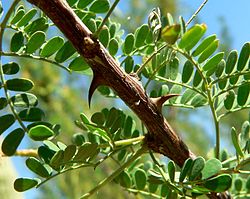Acacia

| Acacia | |
|---|---|
 | |
| Scientific classification | |
| Kingdom: | |
| Division: | |
| Class: | |
| Order: | |
| Family: | |
| Subfamily: | |
| Tribe: | |
| Genus: | Acacia |
| Species | |
| About 1,300; see List of Acacia species | |



Acacia is a genus of shrub or tree are belonging to the subfamily Mimosoideae of the family Fabaceae, first described in Africa by the Swedish botanist Carl Linnaeus in 1773. Many non-Australian species tend to be thorny, whereas the majority of Australian Acacias are not.
Defences[change | change source]
Acacias are heavily defended against herbivores. Different species have different combinations of defenses:
- Thorns (except Australia)
- Chemicals: bitter tannins and psychoactive alkaloids are common in Acacias. Some species have up to 40% tannins in their bark[1]
- Ants: in Africa and Central Americs, symbiosis with ants can deter all sizes of enemy, from elephants to caterpillars and stem-boring beetles.[2] Some species of ants will also fight off competing plants around the acacia, cutting off the offending plant's leaves with their jaws and ultimately killing it. Other associated ant species appear to do nothing to benefit their hosts.
Products from the acacia plants have often been used for medicinal purposes.
Gum arabic[change | change source]
Various species of acacia yield gum. True gum arabic is the product of Acacia senegal, abundant in dry tropical West Africa from Senegal to northern Nigeria.
Acacia arabica is the gum-Arabic tree of India, but yields a gum inferior to the true gum-Arabic.
The Whistling Thorn (Acacia drepanolobium)[change | change source]
This species of acacia grows two kinds of thorns. The main defense is provided by pairs 5cm long arranged nearly at a right angle. Smaller stipular spines grow between the pairs of big thorns. These emerge from hollow galls, bulbous swellings 2 to 3cm across. One of four different species of ant lives in each of these igloos, which they open up by cutting holes into them. A dying bush whistles as the wind blows over these entrances. Most acacias make toxins that rush to leaves that are under attack by browsers. The whistling thorn does not. It is infested with stinging ants that swarm out and prepare to bite anything they can when the branch is disturbed. Most browsers seem to avoid infested bushes, perhaps because the ants stink of formic acid.
References[change | change source]
- ↑ Plants for a Future Database
- ↑ Heil, Martin; Greiner, Sabine; Meimberg, Harald; Krüger, Ralf; Noyer, Jean-Louis; Heubl, Günther; Eduard Linsenmair, K.; Boland, Wilhelm (July 2004). "Evolutionary change from induced to constitutive expression of an indirect plant resistance : Abstract : Nature". Nature. 430 (6996). www.nature.com: 205–208. doi:10.1038/nature02703. PMID 15241414. S2CID 4416036. Retrieved 2008-04-20.
Other websites[change | change source]
![]() Media related to Acacia at Wikimedia Commons
Media related to Acacia at Wikimedia Commons
![]() Data related to Acacia at Wikispecies
Data related to Acacia at Wikispecies